
October 2009
Fight for a Workers and Peasants Government!
Against Coups in Central America
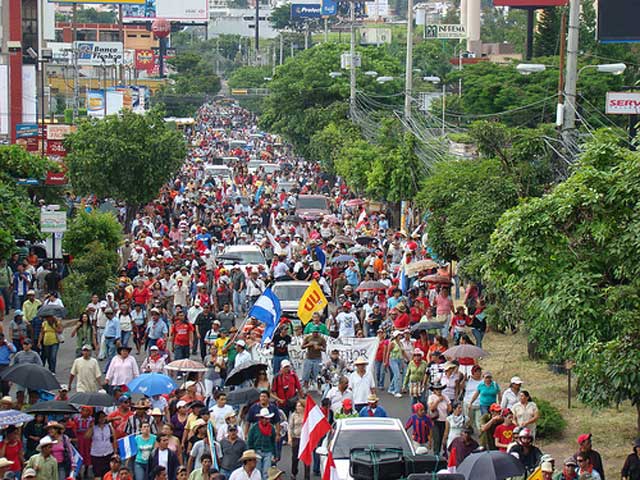
Mass march against the coup and the repression unleashed by the dictatorship, Tegucigalpa, August 11.
Photo: Honduras Laboral
The
following article, translated from El Internacionalista, is based on a presentation at an August 21
forum of the Grupo Internacionalista, section of the League for the
Fourth International, at the National University of Mexico (UNAM).
The June 28 coup d’état in Honduras
set off a regional
and continent-wide crisis which is still continuing. Its intensity not
only has
not diminished, it has sharpened, mainly due to the resistance of the
working
people who have not given up an inch in the face of the brutal
repression by
the dictatorship that has taken over the Central American country.
Despite the
efforts of the coup plotters to stay in power through delaying tactics,
sustained by the de facto recognition of the de facto regime by its
imperialist
master, the United States, they have not been able to restore order.
Despite
all the beatings, the torture and murders, the Honduran workers and
peasants,
the teachers and students, the indigenous peoples, the black
Garífuna
population and women in particular remain on battle footing. Their
heroic
example is an inspiration to all.
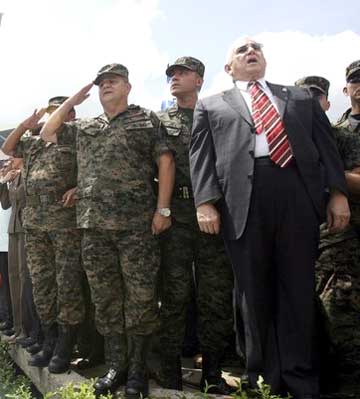 The visible heads of the coup
d’état: the puppet "president" Roberto Micheletti (in suit and
tie) and General Romeo Vásques (saluting).
The visible heads of the coup
d’état: the puppet "president" Roberto Micheletti (in suit and
tie) and General Romeo Vásques (saluting).
Photo: Reuters
When
General Romeo Vásquez Velásquez1
ousted
the president of the republic, Manuel Zelaya Rosales – arresting him at
gunpoint in his home, kidnapping and exiling him to Costa Rica in his
pajamas,
and then installing as puppet president the head of the Honduran
Congress,
Roberto Micheletti Baín – he surely thought that the problem had
been resolved.
It didn’t turn out that way. Clearly, this act of force was in response
to the
desire of the reactionary ruling classes of Central America, spurred on
by
imperialist ultra-rightists, to get rid of the “moderate center-left”
presidents who have been elected throughout the region. Everything
indicates
that they chose Honduras because it had the weakest political left in
the
isthmus. Zelaya, the head of the traditional Liberal Party, did not
have the
mass apparatus of the FMLN in El Salvador or the FSLN in Nicaragua. But
they
miscalculated. They didn’t take into account that Honduras has the
strongest
trade-union movement in the area, and it is the unions that have been
the
backbone of the resistance.
The civilian-military coup d’état
unleashed a
nightmare for the Honduran masses, and not just for them. In fact, it
threatens
all of Latin America with a return to the times of the military
dictatorships,
of the dirty wars and the death squads of the 1970s and ’80s. Everyone
understands that if the gorilas
(reactionary military officers) manage to consolidate their domination
in
Honduras, the same thing could take place tomorrow in Ecuador or
Bolivia. The
question that is posed is how to eradicate this plague that has beset
Latin
America for decades, and in order to answer that it is necessary to
analyze its
context, its roots and its scope. To suppose that the solution is to be
found
in merely reestablishing “constitutional order” by restoring President
Zelaya,
or even that it can be resolved in a bourgeois-democratic framework, is
to
ignore the class forces which produced the coup, as well as the web of
complicity extending from Tegucigalpa to Washington, D.C. In reality,
only
through international socialist revolution is it possible to eradicate
the
threat of constant coups, which are inherent in Latin American
capitalism under
imperialist domination.
In the final analysis, despite the denials by
U.S.
spokesmen, this coup was “made in U.S.A.” And this fact has enormous
importance
in devising a strategy to fight it.
It must be
stressed, as we have done, that the Honduran military uprising is “the
first
coup of the Obama administration.” In Latin America, there have been
many
illusions in the election of the U.S. president, reputed to be a
liberal and a
critic of the war in Iraq. He was seen as the “anti-Bush.”
Fewer illusions, perhaps, than in the United
States, where the election of the first black president represented a
significant social shift, but not the heralded political “change.”
Great hopes
were erroneously placed in Barack Obama, and while the Internationalist
Group
warned from the outset that he was a warmonger and defender of the
bankers, practically
the entire U.S. left, either directly or indirectly, aided his
election. Due to
their inveterate opportunism, they fed the illusions rather than
fighting them.
Nevertheless, seven months after taking
office, the
Obama administration has turned out to be, in terms of its political
content,
the third term of George Bush II. Its leading personnel comes largely
from the
team of Bill Clinton, with the addition of the chiefs of the War
Department and
Treasury, who carried out the same functions under Bush. This
continuity in
personnel constitutes a loyalty oath to Wall Street and the Pentagon,
demonstrating that it is the same old Yankee imperialism. In his
“national
security” policies, in the imperialist war and colonial occupation of
Iraq and
Afghanistan, Obama is following in the footsteps of the Bush
administration,
and has even intensified military strikes inside Pakistan. The torture
and
massacres of the civilian population of Afghanistan continue, as well
as the police-state
measures against democratic rights in the United States.
In Latin America, the U.S. Navy’s Fourth
Fleet has
been reactivated, after having been dissolved in the 1940s. Now a new
agreement
is about to be signed with Colombia giving U.S. forces access to seven
Colombian military bases, in addition to the six where they already
have
hundreds of American military “advisors” and intelligence agents. And
despite
the announcement by the Ecuadorian government of Rafael Correa that he
would
not renew the contract for the use of the air base at Manta (which
returned to
Ecuadorian control in mid-September), the United States is encircling
Hugo
Chávez’ Venezuela with a military cordon. As the Venezuelan
president rightly
remarked, the winds of war are blowing in the region.
It was in this framework that the military
coup in
Honduras was plotted that overthrew President Zelaya, accused of being
the
beachhead for the expansion of chavismo
in Central America. For the U.S. government, Chávez – this
bourgeois
populist-nationalist who hasn’t expropriated anything, and whose few
nationalizations are actually commercial transactions which have turned
out to
be quite lucrative for the companies involved – has apparently replaced
“Castro
communism” as the fearsome spectre stalking Latin America.
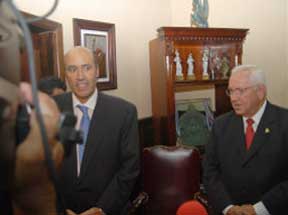 Collusion:
U.S. ambassador (and Cuban gusano) Hugo Llorens with then-president of
the Honduran Congress, Roberto Micheletti,
in September 2008.
Collusion:
U.S. ambassador (and Cuban gusano) Hugo Llorens with then-president of
the Honduran Congress, Roberto Micheletti,
in September 2008.
We have published the details showing that
the U.S.
was up to its neck in the plotting of the putsch, even discussing with
the
future authors of the coup about how to go about arresting the
president who
was elected by popular vote2.
Assistant Secretary of State Thomas Shannon traveled to Tegucigalpa for
this
purpose a week before the overthrow of Zelaya. We noted how the coup
regime has
hired prominent lobbyists linked to the Clintons to be its
representatives in
Washington. It’s also noteworthy that prominent liberal groups like the
Washington Office on Latin America went after Zelaya during the days
before the
coup over his plans to hold a non-binding poll on whether a constituent
assembly should be called. But if this sent shivers down the backs of
the Honduran
ruling class, together with the 60 percent increase in the minimum wage
ordered
by Zelaya last year, what got Washington in a tizzy were the
increasingly close
ties between the Honduran president and the Venezuelan president in the
framework of the Bolivarian Alliance for the Americas (ALBA).
Another element placing the civilian-military
coup in
a regional framework was the coordinated replacement of American
ambassadors to
the governments of Nicaragua, Honduras, Guatemala and El Salvador in
August
2008: Hugo Llorens3
was
dispatched to Tegucigalpa, Robert Blau was sent as chargé
d’affairs to San
Salvador, Stephen McFarland to Guatemala and Robert Callahan to
Managua. All of
them studied at the United States War College in Washington, all worked
at the
U.S. embassy in Iraq, and all of them were officials of the National
Intelligence Directorate under John Negroponte, who was known as The
Proconsul
during his years as U.S. ambassador to Honduras in the 1980s. From that
position he ran the death squads in El Salvador, the murderous
“contras” in
Nicaragua, and Battalion 316 in Honduras, which assassinated and
“disappeared”
hundreds of left-wing activists and imposed a reign of terror on the
country.
Today the ghosts of yesteryear have returned
to
Honduras. Hours after the coup, Billy Joya Améndola, notorious
as one of the
bloodiest butchers of Battalion 316, appeared on Honduran television
screens as
the “minister counselor” of Micheletti in his failed bid to become the
candidate of the Liberal Party in this year’s elections. Replying to
accusations that he was responsible for the death or disappearance of
16 people
in the 1980s, Billy Joya told a reporter for the New York
Times (8 August): “The policy at that time was, ‘The only
good Communist is a dead Communist.’ ... I supported the policy.”
Interestingly, Joya, like much of the Honduran “elite,” has permanent
residency
in the United States, the famous “green card,” and in recent weeks
moved his
family to Miami. It has also been reported that many of the businessmen
behind
the coup have sent their families to the U.S., in case things go awry.
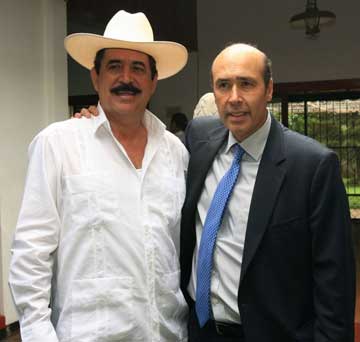 The devil’s embrace: Honduran president
Zelaya with the Yankee ambassador Llorens, in Managua, July 30. Photo: Reuters
The devil’s embrace: Honduran president
Zelaya with the Yankee ambassador Llorens, in Managua, July 30. Photo: Reuters
It should not be forgotten that the military
coups in
Honduras in 1956, in 1963 (the bloodiest, which brought to power the
father of
Zelaya’s foreign minister, Patricia Rodas), in 1972, in 1975 and in
1978 all
sought the support of U.S. imperialism and attacked the workers
movement. Even
when there were supposedly civilian regimes, these were only a disguise
to mask
military domination. So in order to eliminate military coups and
military
regimes in civilian disguise, which have been a constant in Honduran
history,
it is necessary to break with the system that generates them:
imperialism. In
the first days (after June 28), many of those who opposed the Honduran
coup
called on the U.S. to disavow the coup plotters. Hugo Chávez
appealed, “Obama,
do something.” We in the League for the Fourth International, in
contrast,
insisted, “Yankee Imperialism, Hands Off!” We did not beg Obama to
restore
Zelaya to the presidential seat. We demanded that the U.S. pull its
troops out
of the military base of Soto Cano (Palmerola) along with its agents
throughout
the country, and we called on the Honduran workers to expel the
imperialists.
We also did not call on the Organization of
American
States (OAS), that body which Ernesto “Ché” Guevara rightly
called the Yankee
ministry of colonies, nor did we ask for the intervention of Latin
American
bourgeois governments like Brazil, Chile and Argentina. If they came
out
against the Honduran coup, so much the better; but as subjects, allies
and
junior partners of U.S. imperialism, their posture has been to
negotiate a
deal, like the ill-starred “Agreement of San José,” which calls
for the return
of Zelaya without presidential powers and for coexistence with
Micheletti &
Co. Working people should reject any “dialogue” with the golpistas,
who only “dialogue” with guns and truncheons. “Amnesty”
for these criminals amounts to impunity. Neither forgiving nor
forgetting for
the coup plotters! We do not call on bourgeois forces to negotiate a
deal with
the gorilas. On the contrary, we
fight for workers mobilization to smash the coup.
Bring Down the Coup
with Class Struggle!
Meanwhile, a wave of repression has been
unleashed
over Honduras without precedent in the history of the country.
Thousands have
been arrested so far (17,000 by the end of September, according to the
estimates of human rights groups; as many as 30,000 by other counts).
The
“forces of law and order” have been dealing out brutal beatings in the
streets
in order to “teach a lesson” to the protesters, while in the shadows
they shoot
and knife teachers in particular. Nothing is known of the whereabouts
of
hundreds of peasants arrested on any pretext after marching hundreds of
kilometers to express their opposition to the coup. When a crowd of up
to
100,000 opponents of the military takeover flocked to the Airport of
Toncatín
on July 4 to salute President Zelaya on his attempted return, a sniper
in
uniform murdered a 16-year-old youth, Isis Obed Murillo, with a shot to
the
heart. When his father, a Protestant minister, sought to protest this
atrocity,
he was arrested. Later, two teachers – Roger Vallejo and Martín
Riviera – were
vilely murdered, reflecting the leading role of the teachers unions in
the resistance
to the government of usurpers.
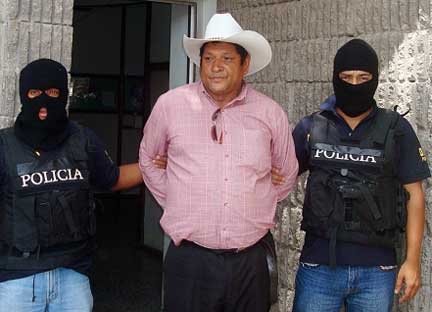 The death squads are back. José
Murillo Sánchez, when he attempted to protest the assassination
of his son Isis Obed by an army sharpshooter, was arrested by police
officers in ski masks.
The death squads are back. José
Murillo Sánchez, when he attempted to protest the assassination
of his son Isis Obed by an army sharpshooter, was arrested by police
officers in ski masks.
Photo: CIPRODEH
Perhaps the most sinister aspect of the
repression is
not so much the death toll, but the fact that the military forces go
out of
their way to brutally and systematically attack demonstrators with riot
clubs
and steel bars instead of bullets. Here you can see the hidden hand of
their
U.S. military “advisers” who advise them to avoid creating martyrs. In
the same
way, when torture is accompanied by doctors and psychiatrists who
advise the
torturers when they should take a break in order to avoid killing the
“subject,” it is a telltale sign that “scientific” repression is being
carried
out with the trademark of the CIA. The Honduran high command is a bunch
of
bloody psychopaths who wouldn’t hesitate for a second to give the order
to
massacre thousands of their “compatriots.” If, for now, they are
concentrating
on dealing out kicks and blows, you know with absolute certainty that
they are
being instructed by Joint Task Force Bravo of the U.S. Army, stationed
at the
military base of Soto Cano in Palmerola, no matter what Pentagon
spokesmen say
about their supposed non-participation in the coup.
(Now they are experimenting with new “crowd
control”
weapons, such as the Long-Range Acoustical Device, or LRAD, which is
being used
against the Brazilian embassy in Tegucigalpa where President Zelaya is
ensconced, and which has previously been used in Afghanistan, Iraq and,
most
recently, against anti-globalization demonstrators in Pittsburgh,
Pennsylvania.)
The Honduran military takeover – supported
and even
instigated by the overwhelming majority of the capitalist class;
approved by
the National and Liberal parties in the Natiojnal Congress; “legalized”
by
order of the slavish Supreme Court, totally controlled by the same
parties; and
sanctified with the benediction of both the Catholic archbishop and of
the top
Protestant prelates – represents a blood-curdling threat to democratic
rights
and the fundamental interests of the Honduran masses in one of the
poorest
countries of Latin America. It was also motivated by capitalist class
interests. It was carried out, among other reasons, in order to
intensify the
exploitation in the maquiladoras, the
free trade zone factories, which produce for the capitalist world
market. As we
have pointed out, despite being a small country, Honduras has the
third-largest
number of maquiladora workers in the world.
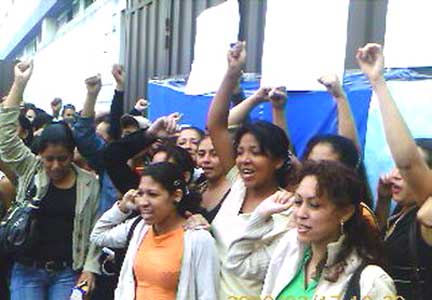 Around 1,000 women workers at the Index
maquiladora in Comayagüela demonstrated on February 17 to demand
payment of the minimum wage decreed by the administration of Manuel
Zelaya in December of last year. Photo: El
Heraldo
Around 1,000 women workers at the Index
maquiladora in Comayagüela demonstrated on February 17 to demand
payment of the minimum wage decreed by the administration of Manuel
Zelaya in December of last year. Photo: El
Heraldo
What this means is that the country which in
the past
was the archetype of the “banana republic” is today a “maquiladora
republic.”
This has a contradictory aspect: on the one hand, Honduras is directly
under
the iron heel of imperialism, subject to the commandments of American
capitalists. But on the other hand, its integration into the world
economy,
particularly through the Central American Free Trade Agreement (CAFTA)
means
that the fate of the Honduran workers is bound up with that of the
workers
movement around the world. This underscores the importance of
international
labor action to resist the coup. The International Transport Workers
Federation
(ITF) has called to boycott Honduran-flag vessels when they enter
unionized
ports. If in fact the cargos of bananas or of clothing and shoes
manufactured
in the Honduran factories of Gap, Nike and Adidas were prevented from
unloading, this could push the imperialist godfathers of the Honduran
coup
plotters to dump their puppets. But so far, the call of the ITF for
labor
action has remained a dead letter, due to the labor bureaucracy’s
“respect” for
capitalist legality.
Inside Honduras, it has been above all the
unions,
along with agricultural cooperatives, who have organized the
resistance. The
teachers unions, in particular, have played a leading role, with a
general
strike of the schools that lasted three weeks beginning on June 29,
followed by
a rotating strike (three days of classroom instruction followed by two
days on
strike). The union hall of the bottling plant workers union, STIBYS,
has served
as the organizing center for the demonstrations, and the president of
that
union, Carlos Reyes, is one of the main leaders of the protests. There
were
national 48-hour work stoppages in the last two weeks of July. However,
they
have been largely limited to the public sector, and they have a
multi-class
character: “civic work stoppages” rather than workers strikes. This
reflects
the popular-front character of the opposition to the coup, headed by a
coalition that “unites” the workers with a sector of the capitalists.
The
National Front Against the Coup d’État (FNCGE) includes a small
bourgeois
party, Democratic Unity, and dissident sectors of the Liberal Party.
More
generally, the struggle to bring back “Mel” Zelaya seeks to pull
together all
those opposed to the coup around a lowest-common-denominator program,
thereby
ensuring that resistance is limited to the capitalist framework.
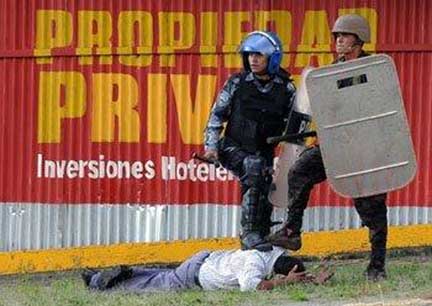 The
military officers carried out their coup in order to defend the
interests of a few property owners. However, these were not an “oligarchy”
but the core of the capitalist ruling class. To defeat them and put an
end to coups, a workers revolution is needed.
The
military officers carried out their coup in order to defend the
interests of a few property owners. However, these were not an “oligarchy”
but the core of the capitalist ruling class. To defeat them and put an
end to coups, a workers revolution is needed.
In a previous article on the coup in
Tegucigalpa4
we
dealt with the theme of the “oligarchy,” which many leftists bandy
about. They
denounce the “rancia oligarquía
hondudreña” (archaic Honduran oligarchy) in order to justify
their
popular-front politics. The implication is that while the tops of the
ruling
class support the coup, there are supposedly other bourgeois sectors
that
don’t. We explained that, in contrast to more economically advanced
capitalist
countries where the reference to an oligarchy is a pure invention, in
Honduras
the domination of a tiny number of families and clans persists, but that this “oligarchy” is nothing other
than the bourgeois ruling class. The few capitalist opponents of
the coup
are no more than “the shadow of the bourgeoisie,” as Trotsky described
the
bourgeois component of the Spanish Popular Front during the 1930s Civil
War.
The reformist left wants to ally with them not because it would make
the
opposition stronger, but to make it more acceptable to the powers that
be, and
to put a lock on the action of their own ranks, so that they don’t go
“too
far.”
In accordance with the Trotskyist program,
the League
for the Fourth International calls to mobilize the Honduran working
people
against the coup not for the aim of reinstating the presidency of
Zelaya, a
bourgeois conservative, but for the purpose of fighting for a workers
and
peasants government to sweep away the coup plotters and bring down the
capitalist system that breeds them. That is why we call to mobilize the
workers
in a general strike, to form workers self-defense groups against
repression. We
fight alongside Zelaya supporters against the coup mongers, at the same
time as
we warn that the deposed president is also a capitalist politician who
responds
to the demands of imperialism. This will be a difficult struggle at the
present
time when demonstrators are shouting, “Mel,
amigo, el pueblo está contigo!” (Mel, our friend, the people
are with you).
But it will prepare those who oppose the coup for the revolutionary
struggle
that is the only positive outcome for the exploited masses.
Zelaya has already accepted the constraints
that the
U.S. imperialists want to impose on him in the so-called “San
José Agreements,”
which so far are unilateral, because the Micheletti, Vásquez
Velásquez, Facussé
and the rest don’t accept them. In particular, in the face of the
insistence by
the Department of State, the Honduran president gave up the demand for
a
constituent assembly. This slogan has recently become the rallying
point for
the centrist and reformist left in Latin America: having lost
confidence in
socialist revolution and the revolutionary capacity of the proletariat,
they
fly the banner of one or another variant of a (bourgeois) “democratic
revolution.”
They call for constituent assemblies everywhere, even in countries that
for quite
some time have had all the forms of truncated bourgeois “democracy.”
For
revolutionary Marxists, on the other hand, the call for a constituent
assembly
is applicable in feudal or semi-feudal countries, or where there is an
essentially anti-democratic “bonapartist,” military/police regime5.
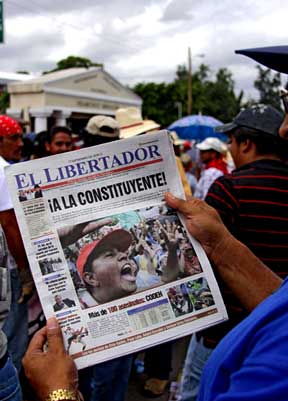 Despite
the demands of his supporters, Manuel Zelaya has already dropped the
demand for a constituent assembly, which was one of the issues that set
off the coup d'état, due to the insistence of the bourgeoisie on
preventing at any cost all changes to its tight system of domination. (Photo: Indymedia/Honduras)
Despite
the demands of his supporters, Manuel Zelaya has already dropped the
demand for a constituent assembly, which was one of the issues that set
off the coup d'état, due to the insistence of the bourgeoisie on
preventing at any cost all changes to its tight system of domination. (Photo: Indymedia/Honduras)
In Honduras today, there is such a military
dictatorship, slightly veiled by the approval of the institutions of a
pseudo-democracy under military supervision, the guard dogs of the
narrow,
semi-colonial capitalist class. Even before the coup, the “democratic”
attire
of the Honduran state was threadbare. The current constitution was
issued in
1982, under the tutelage of U.S. Proconsul Negroponte, in order to
provide the
trappings of a “state of law” to the regime of the death squads, which
served
as a launching pad for the Nicaraguan contras and as a “ground-based
aircraft
carrier” for the Pentagon in Central America. As a result of a series
of coups,
the head of the armed forces was named not by the president of the
republic, or
by any other civilian authority, but by the all-powerful High Council
of the
Armed Forces (COSUFA). For a quarter century, from 1954 to 1981, not a
single
head of the armed forces left his post without becoming president of
the
country. For its part, the supposedly independent judicial branch is
nothing of
the sort: the Supreme Court is a condominium of the two traditional
parties and
the presidency.
However, behind this “democratic deficit”
there are
important class interests. The tiny
Honduran bourgeoisie has repeatedly resorted to military government
because of
its scant social weight in comparison to the large mass of working
people that
it, and its imperialist patrons, mercilessly exploit. While fighting
alongside
those calling for a constituent assembly, we stress that such a body
cannot
solve fundamental social issues, and to think that this can be achieved
with a
new constitution reflects dangerous democratic illusions. One only has
to look
at the recent experience of Ecuador, where a constituent assembly
called by
President Rafael Correa issued a new constitution in mid-2008. Despite
all the
fanfare about “refounding the country,” the new Carta Magna ended up
protecting
private property, providing guarantees for “multinational”
corporations, and
authorizing mixed companies in strategic sectors of the economy, such
as oil.
Any constituent assembly called by a
capitalist
government, whether headed by a Manuel Zelaya, an Evo Morales or even a
Salvador Allende, will end up being a swindle – and not just because of
the
opposition of a Stone Age right wing or “betrayals” by “center-left”
governments, but because one cannot alter the fundamentals of the
system of exploitation
and oppression under capitalism. To put an end to the infernal cycle of
military coups, to escape from the clutches of imperialism, to break
the power
of the large landowners or solve the age-old oppression of the
indigenous
peoples – not to mention freeing the banana workers and women
maquiladora
workers from wage slavery in imperialist-owned companies – will take
international
socialist revolution.
This perspective reflects the theory of
permanent
revolution developed by Leon Trotsky, which summed up the experience of
the
Russian Revolutions of 1905 and 1917. Citing the phenomenon of combined
and
uneven development, in which modern factories exist side-by-side with
antiquated economic forms, he concluded that in the imperialist epoch,
the weak
bourgeoisies in semi-feudal or semi-colonial countries are incapable of
carrying out the tasks of the great bourgeois revolutions of the past.
Agrarian
revolution, democracy and national liberation can only be achieved by
the
taking of power by the working people. Consequently, Trotskyists call
for a
revolutionary workers party, to fight for a workers and peasants
government to
bring down the present-day capitalist state. Then, following a
victorious
insurrection, a revolutionary constituent assembly could ratify the new
state
based on workers and peasants councils that would carry out these
democratic
tasks by expropriating the bourgeoisie and extending the revolution.
For a Central American
Federation of Workers
Republics!
To achieve such gains, and simply in order to
definitively defeat the coup mongers, one must go beyond the national
boundaries of Honduras. As we have pointed out, the origins of the coup
are to
be found in the Central American framework and domination by U.S.
imperialism.
We have quoted how the spokesman for ARENA, the party of the death
squads in El
Salvador, threatened Salvadoran president Mario Funes with the same
fate as
Zelaya. Looking over a list of “Who Is Who” among the businessmen
behind the
coup, one sees that many of them – like José Lamas, Jorge Faraj
or Miguel
Facussé – have companies and economic interests in other Central
American
countries. However, despite all the sympathy for the courageous
Honduran
fighters, and even with all the declarations of solidarity, there have
not been
big mobilizations in the rest of the region to undertake a joint
struggle. And
for a very concrete reason: the Central American left is dominated by
petty-bourgeois – and now bourgeois – nationalism, rather than
proletarian
internationalism.
It should be noted that at the moment of
winning
independence from Spain there was a single state on the isthmus, the
Federal
Republic of Central America. The formation of five mini-republics was
the
result of conservative reaction linked to the church and the large
landowners
who opposed the liberal reforms. More generally, this was due to
insufficient
development of the productive forces that could sustain a consolidated
country.
This phenomenon was seen all over Latin America, such as in Argentina
where a
national state was only cohered in the middle of the 19th century under
the caudillo (strong man) Juan Manuel de
Rosas. It was also the case in Mexico, where this consolidation did not
take
place until the victory of Benito Juárez over the conservatives
and the French
army of Emperor Maximilian in 1867. In Mexico and Argentina, extensive
railroad
networks unified national markets; in Central America this did not
occur. In
Central America, due to greater economic backwardness and being more
directly
subjected to North American expansionism, the nation-building effort
failed
with the defeat and execution of General Francisco Morazán in
1840. Then came
the filibusters like William Walker, who was invited by Nicaraguan
reactionaries but then took over the republic and sought to conquer the
whole
of the isthmus seeking to join the United States as a slave state.
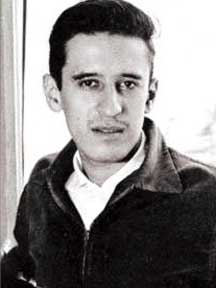 Roque
Dalton
Roque
Dalton
Ever since, Central American unity has been a
dream of
progressive forces, while the “archaic oligarchies” dug in to their
piece of
the isthmus. In our times, revolutionary figures have referred
ironically to the
tiny size of their states, as for example the poet and guerrilla leader
Roque
Dalton did with his references to El Salvador as the “Tom Thumb of
America.”
The Honduran reactionary Micheletti, on the other hand, says that there
is no
point to talk with El Salvador, because it is a field to small to play
soccer
on, that when you kick the ball it lands in another country. Maybe he
was
trying to avenge himself for the so-called “Soccer War” of 1961, when
Honduras
lost to the Salvadoran army. In reality, these sorts of national
conflicts were
whipped up by reactionary forces in order to distract the attention of
the
working people from the class war. Genuine revolutionaries didn’t take
sides in
the 1961 war, any more than they did in the war between Bolivia and
Paraguay in
the 1930s.
Still, historically left-wing forces in
Central
America have been dominated by a nationalist vision and politics. In
the 1980s,
the Sandinista National Liberation Front (FSLN) governed Nicaragua,
while the
Farabundo Martí National Liberation Front (FMLN) waged a civil
war in El
Salvador. The imperialists always accused the Sandinistas of financing
and running
the Salvadoran guerrillas, but the FSLN actually did precious little to
aid its
comrades of the FMLN, and even less for the tiny groups of guerrillas
in
Honduras. Before that, in the 1960s, there were a host of guerrilla
groups in
Guatemala, including the MR-13, FAR, EGP, ORPA and the local Communist
party,
the Guatemalan Party of Labor (PGT). Even the politically most advanced
of
these, the Movimiento Revolucionario 13 de Noviembre, which said it was
fighting for socialist revolution (while the others only called for a
bourgeois
“democratic” revolution), restricted its struggle to Guatemala,
although a
number of Latin American militants (including several who saw
themselves as
Trotskyists) supplied them with money and military supplies, for which
some
like the Mexicans David Aguilar Mora and Eunice Campirán were
vilely assassinated
by the Guatemalan army, and others, like the Argentine Adolfo Gilly
were jailed
for years in Mexico.
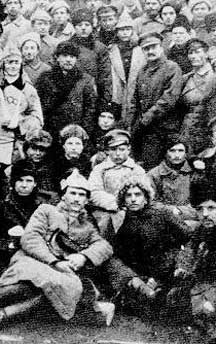 Lenin
and Trotsky with Red Army troops in 1921. Stalin renounced the
Bolshevik program of the October 1917 Revolution for international
socialist revolution, and later blocked proletarian revolutions by
means of the popular front.
Lenin
and Trotsky with Red Army troops in 1921. Stalin renounced the
Bolshevik program of the October 1917 Revolution for international
socialist revolution, and later blocked proletarian revolutions by
means of the popular front.
They had a nationalist outlook for several
reasons.
First, because of the influence Stalinism, which abandoned the program
of the
October Revolution – for international socialist revolution – in favor
of a
conservative, nationalist program reflecting the mentality of the
parasitic
bureaucracy that seized power in the workers state following Lenin’s
death in
1924. This program was summed up in the slogan of building socialism
“in a
single country,” which is an impossibility given the worldwide
character of socialism.
Moreover, what was built in the USSR was not socialism, a classless
society,
but rather a bonapartist regime, a bureaucratically degenerated workers
state,
that required a political revolution to open the way to socialism. The
counterpart of this dogma, the popular front, was intended to pave the
way for
the desired “peaceful coexistence” between the USSR and imperialism by
blocking
proletarian revolutions in other countries, using Marxist-sounding
language as
it politically chained the workers movement to sections of the
bourgeoisie.
A second reason
that nationalism continues to predominate is that all these movements
had their
social base in the peasantry, a contradictory petty-bourgeois social
layer
which lacks the solid class interests necessary to reconstruct the
nation, as
is the case with the fundamental classes, the bourgeoisie (which seeks
to build
a capitalist society) and the proletariat (whose interests will be
expressed in
socialism). The peasantry is historically the cradle of nationalist
movements.
Its lower layers, landless peasants, are natural allies of the
proletariat,
while middle peasants – small producers who do not exploit the labor of
others
– can join with workers revolution to get rid of the yoke of the landed
estate
owners, as occurred in the Russian Revolution of 1917. But in “normal”
times,
the property-owning peasantry is easy prey for the bourgeoisie, on
which it depends
for seeds and to market its products. However, the victory in Cuba of
the peasant-based
rebel army led by Fidel Castro, Ernesto “Ché” Guevara and Camilo
Cienfuegos,
who overthrew the tyrant Fulgencio Batista on 1 January 1959, inspired
a whole
series of guerrilla movements in Latin America who took to the hills
seeking to
reproduce what was an exceptional case.
The Trotskyists of the League for the Fourth
International and its Mexican section, the Grupo Internacionalista,
defend Cuba
deformed workers state against imperialism and counterrevolution,
whether
internal or external. At the same time, we fight for a proletarian
political
revolution to establish genuine soviet democracy in place of the
present
bureaucratic regime, in which basic decisions are made by a small
petty-bourgeois layer, whether the current leadership of the Cuban
Communist
Party under Raúl Castro or whoever was in Fidel Castro’s jeep
during the early
years.
In Central America in the 1970s, the FSLN led
by
Carlos Fonseca Amador, and later by Daniel Ortega, Tomás Borge
and Jaime
Wheelock, took its inspiration from the example of Castro’s Cuba and
the
struggle of insurgent general Agusuto Sandino against imperialism and
its
puppets in the 1920s. But upon coming to power, following Castro’s
advice the
FSLN did not seek to build a “second Cuba,” but rather to form a
government
with bourgeois sectors led by Violeta Chamorro, whose husband was
assassinated
by the dictator Somoza. The coalition with Chamorro didn’t last long.
What
followed in Sandinista Nicaragua for almost a decade was a
petty-bourgeois
regime. It was far from being a workers state – the economy remained in
the
hands of the local bourgeoisie – but neither was it a capitalist state,
since
the capitalist army of Somoza had been shattered and the Sandinista
Army wasn’t
committed to the defense either of capitalist property or the
collectivized
property of a workers state.
After a decade in power, under the pressure
of U.S.
imperialism with its economic blockade and military siege by the
mercenary army
of the contras, in 1987 Daniel Ortega signed the Esquipulas Agreement,
orchestrated by the same Oscar Arías, president of Costa Rica,
who today is
acting as “mediator” in Honduras. In 1989, the FSLN suffered an
electoral
defeat at the hands of a bourgeois opposition coalition led by Chamorro
and
lost political power. There followed 16 years of domination by
right-wing
governments in which corruption reached unheard-of heights and the
poverty of
the Nicaraguan masses continually deepened. Then in 2006, Daniel Ortega
was
reelected as president and the FSLN now has a majority in Congress,
only this
time as a thoroughly bourgeois politician and political party. Formally
the
regime presided over by Ortega calls itself the Government of
Reconciliation
and National Unity, making clear its commitment to ally with other
bourgeois
sectors, despite the fact that it faces a furiously anti-Sandinista
opposition,
no matter how rightist the government’s policies may be.
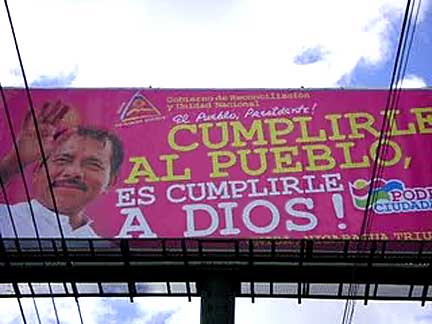 Religioin
and capitalism: the reborn Christian Daniel Ortega serves the owners of
the maquiladoras while Nicaraguan workers are still mired in poverty.
Religioin
and capitalism: the reborn Christian Daniel Ortega serves the owners of
the maquiladoras while Nicaraguan workers are still mired in poverty.
The capitalist character of the current
Sandinista
government is reflected in its stance toward the growing working-class
discontent. Shortly after beginning its new term in office, the
Sandinista
Workers Center (CST) split, forming another federation, the National
Labor
Front (FNT). Both are part of the Sandinista movement; in this sense
they
resemble the corporatist labor bodies in Mexico. (In Mexico during the
1970s,
in the face of dissatisfaction with the corporatist CTM (Mexican
Workers
Federation), the core of the “workers sector” of the long-ruling
Institutional
Revolutionary Party (PRI), the PRI-government formed the Congress of
Labor
(CT), which was also integrated into the state party.) So in Nicaragua
last
year, when there were negotiations over a national labor contract, the
FNT
asked for a 25 percent raise. The CST said that, since it was aware of
the
economic difficulties, it would only ask for 10 percent. And the
Sandinista
government? The labor minister supported the position of the
capitalists,
rejecting any wage increase at all. Then at the official May Day
celebration,
Daniel Ortega told his minister to sit down with the unions and the
employers
and figure out a way to give the workers a few córdobas more.
Another aspect is
that those who are trying to unionize maquila workers complain of the
hostility
of the government, which is seeking to attract maquiladoras.
Then there is the religious aspect. Daniel
Ortega,
after years of proclaiming himself a Marxist, after his electoral
defeat and a
sexual scandal, reinvented himself politically and had himself baptized
as a
reborn Christian. Today all over Managua you can see huge billboards
with a
picture of the president and the motto, “To Serve the People is to
Serve GOD.”
And it’s not just exploiting religion for electoral propaganda like any
other
bourgeois politico. In October 2006, at the height of the election
campaign,
the new Christian Ortega joined with the right wing to prohibit
abortion under
any and all conditions, including when the life of the mother is in
danger. So
all over Latin America there is a struggle for decriminalizing
abortion, while
in Nicaragua therapeutic abortion was banned! Then in November 2007
(after some
80 women had died), the Sandinista government added criminal penalties
to the
ban. In October 2008, the Nicaraguan Police broke into the offices of
the
Autonomous Women’s Movement (MAM), seizing computers and files to
investigate
the accusation that MAM was promoting illegal abortions. And in
November of
that same year, the police prevented hundreds of women from marching in
Managua
on the International Day for Eliminating Violence Against Women.
The Trotskyists of the League for the Fourth
International fight for the unrestricted right to free abortion on
demand,
under high-quality medical care (see “Mexico: For Free Abortion on
Demand,” in The Internationalist No. 26, July 2007).
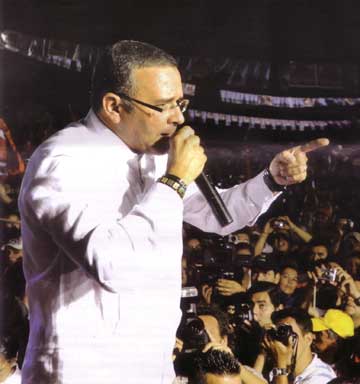 Mario
Funes, TV reporter and talk show host, elected president of El Salvador
as the candidate of the FMLN, says he will consolidate the
“neo-liberal” policies of the previoius rightist governments.
Mario
Funes, TV reporter and talk show host, elected president of El Salvador
as the candidate of the FMLN, says he will consolidate the
“neo-liberal” policies of the previoius rightist governments.
Photo:
José Cabezas/AFP
Today hundreds of thousands of Nicaraguans
are
enduring terrible poverty, far worse then in the plebeian neighborhoods
of the
poorest regions of Mexico. Virtually any tendency to the left of the
FLSN has
disappeared, and those who identify themselves as the “revolutionary,
Sandinista, socialist left” yearn for a (bourgeois) “21st century
socialism” on
the Chávez model (see Correo de Nicaragua
No. 4, May-June 2009). But introducing a few social programs for health
care,
education and subsidies and encouraging cooperatives is a long ways
from
sweeping away capitalism, whose system of exploitation is constantly
reproducing poverty. The “new Nicaragua” of the second coming of the
FSLN
urgently needs a genuine socialist revolution, resulting a class
struggle by
the working people against the capitalist government.
In El Salvador, presidential elections this
past March
led to the victory of Mauricio Funes Cartagena, a popular television
journalist
and talk show host, as the candidate of the Farabundo Martí
National Liberation
Front. His only connection with the guerrilla past of the FMLN is that
as a
reporter he once interviewed some comandantes.
On taking office on June 1, Funes announced that he would not be
subject to the
decisions of the FMLN and that his would be a government of national
unity
(although, like the FSLN, he is hounded by the right). Since ARENA
still
controls the Supreme Court and the Legislative Assembly in alliance
with other
rightist parties, the new “moderate” president will have very
circumscribed
powers of decision-making. Even then, he says he is not opposed to
consolidating the “neo-liberal” policies of the previous governments,
and in
particular the Central American Free Trade Agreement (CAFTA) and the
“Pathways
to Prosperity in the Americas” initiative inaugurated by the Bush
administration which subjugates the Salvadoran economy to U.S.
oversight.
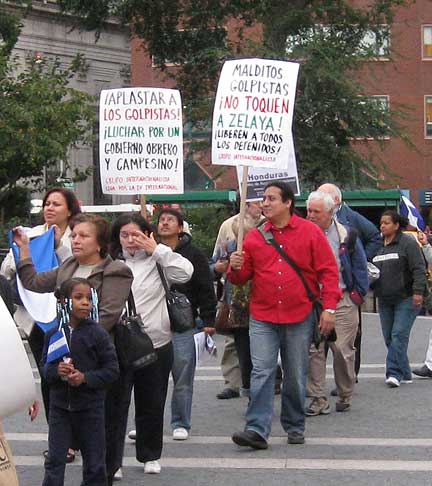 The
Internationalist Group/League for the Fourth International at a protest
in New York City against the Honduran military coup, September 29. Internationalist photo
The
Internationalist Group/League for the Fourth International at a protest
in New York City against the Honduran military coup, September 29. Internationalist photo
Like Honduras, the narrow Salvadoran ruling
class has
modernized without expanding. In fact, a recent investigation by the
Jesuit
magazine Envío (July 2009) concludes
that the traditional coffee-growing oligarchy based on exporting
agricultural
products, the famous “14 families” who dominated the country for a
century, has
been replaced by eight commercial and financial groups. Some of these
capitalists are part of the influential “Friends of Mauricio Funes”
group,
preferring the meritocracy he has promised to the rampant
influence-trafficking
of ARENA. Seeking “stability,” the allegedly “leftist” president would
consolidate one of the most socially stratified countries on earth. And
the
response by Funes to the coup regime in Honduras has been quite weak,
merely
closing the border for 24 hours. But what else would one expect from
this
“center-left” capitalist government? More significantly, there has also
been no
action by the Salvadoran left and workers movement. Where are the labor
boycotts of Honduran exports, the calls for solidarity strikes? In
practice,
there has been a thundering silence from San Salvador to the Honduran
coup.
Also in Mexico, the regional powerhouse,
workers
solidarity with the Honduran working people today confronting ferocious
repression has been almost non-existent. Here as well, and particularly
in the
United States, we must call on independent teachers unions and networks
to
support with deeds their Honduran compañeras and
compañeros who are fighting
under the gun. It’s not just a matter of solidarity actions: it is
necessary to
land blows against the allies of the coup plotters throughout the
region. A
rise of class struggle against the capitalists in El Salvador,
Guatemala,
Nicaragua and Costa Rica would raise the pressure on the bosses of the
mutineers
in Honduras. Above all, it is necessary to begin building the nuclei of
revolutionary workers parties, Leninist and Trotskyist in character, to
lead
the struggle for socialist revolution throughout the region. Given the
regional
and international genesis of the Honduran putsch, it will be difficult
to crush
it in the national framework. Thus it is necessary to beginning
establishing
the links for a Central American federation of workers republics, as
part of a
Socialist United States of Latin America. ■
1 Like many top officers of the Honduran army, General Vásquez attended the U.S. Army’s School of the Americas, known as the “school of assassins” and “school of coup plotters” – twice, in fact, in 1976 and 1984 – although he did not graduate. His main claim to fame prior to his starring role in the 2009 coup was to have gone to prison in 1993 for participation in a car theft ring that specialized in stealing luxury autos (see Al Giordano, “Honduras Coup General Was Charged in 1993 Auto Theft Ring,” Narcosphere, 4 July).
2 See “Honduras: The First Coup of the Obama Administration,” The Internationalist, No. 29, Summer 2009).
3 Llorens is a Cuban gusano (counterrevolutionary exile) who was brought to Miami by the CIA’s Operation Peter Pan in the 1960s.
4 In “Honduras: The First Coup of the Obama Administration.”
5 See our article, “Trotskyism vs. ‘Constituent Assembly’ Mania,” The Internationalist No. 27, May-June 2008.
To contact the Internationalist Group and the League for the Fourth International, send e-mail to: internationalistgroup@msn.com